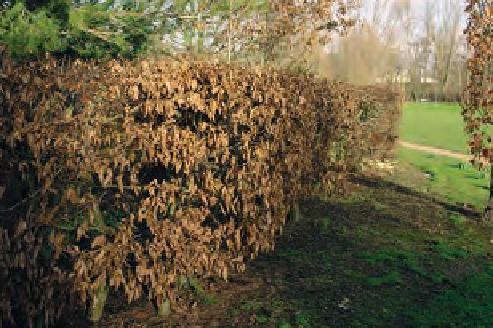Agriculture Reference
In-Depth Information
adult growth after a certain number of leaves are
produced or when it has reached a certain size. Often,
however, an environmental stimulus is required,
such as temperature and/or daylength which links
flowering to an appropriate season. In this way many
plants flower characteristically at particular times of
year, for example
Syringa
vulgaris
(lilac) in the spring,
Buddleja alternifolia
in early summer,
Hypericum
calycinum
in late summer to autumn and
Viburnum
x bodnantense
in the winter. In the reproductive
phase of the life cycle, flowers are potent 'sinks' for
a plant's resources, drawing sugars to them at the
expense of vegetative growth. Plant growth therefore
slows as all the plant's energies are redirected to
producing flowers, fruits and seeds. Adult growth
often shows different growth patterns to juvenile
growth as in ivy and changes in rootability of cuttings
(see above).
In many plants, adult growth is also linked to
producing stores of food towards the end of the
growing season for overwintering and growth the
following spring (
perennation
). Once flowering is
over, sugars may be redirected and stored as starch
in the stems of woody plants or in modified roots,
leaves and stems such as bulbs, rhizomes and tubers
in herbaceous plants. These may also be a means
of vegetative spread (asexual reproduction) and are
useful to the gardener as propagating material (see
Chapters 8 and 11).
Figure 5.10
Carpinus betulus
(hornbeam hedge) in
winter
adult mature stems which bear fruit, and often these
can be found on the same plant.
Pruning for juvenility
If juvenile leaf characteristics are desired rather than
flowers, as in
Eucalyptus
spp. and in others such as
Cotinus
spp. and
Liriodendron tulipifera
(tulip tree),
juvenility may be maintained by
coppicing
, that is,
cutting the plants to a low framework or stool each
year in their dormant seasons. Both coppicing and
pollarding
(where trees are cut to a single stem
a short distance above the ground) are traditional
pruning techniques which have been used for
centuries in woodlands and elsewhere to produce
wood for many purposes such as fencing or leaves
for fodder. When carried out periodically, typically
every 15 years in the case of
Corylus avellana
(hazel)
for example, trees are maintained in a juvenile or
partially juvenile state and this can lengthen their lives
considerably.
The retention of leaves is a useful property in beech
and hornbeam hedges where annual pruning keeps
the plants in juvenile growth and provides an attractive
hedge with colourful leaves retained throughout
the winter (Figure 5.10). This can create additional
protection in windbreaks, although the barrier created
tends to be too solid to provide ideal wind protection
(see p. 132).
Pruning in adult plants
Plant pruning is often carried out to reduce the
competition within the plant for the available
resources. In this way, the plant is encouraged to
grow, flower or fruit in the way the horticulturist
requires. A reduction in the number of flower
buds of, for example,
Chrysanthemum morifolium
(chrysanthemum) will cause the remaining buds to
develop into larger flowers; a reduction in fruiting
buds of apple trees will produce bigger apples, and a
reduction in the branches of soft fruit and ornamental
shrubs will allow the plants to grow stronger when
planted densely.
To encourage flowering and improve the quantity and
quality of blooms,
species that flower on the previous
year's growth of wood (e.g.
Forsythia
) should be
pruned soon after flowering has stopped. Conversely,
species that flower later in the year on the present
year's wood (e.g.
Buddleja davidii
) should be pruned
the following spring, to maximize the growth period
for flower production.
As flowers age, they begin to use up a considerable
amount of the plant's energy in the production of
The adult plant
The adult stage is defined by the ability of the plant
to
reproduce sexually
and
produce flowers
,
fruit
and seed
. The progression from a vegetative to
a flowering plant involves profound physical and
chemical changes. This change may simply be
genetically programmed with a plant switching to

